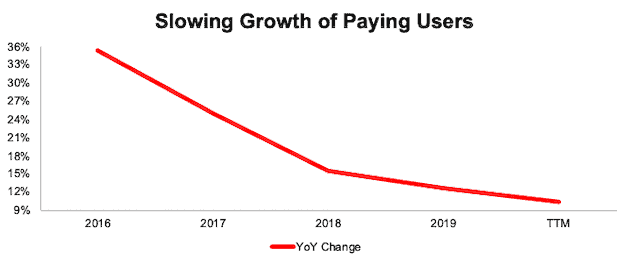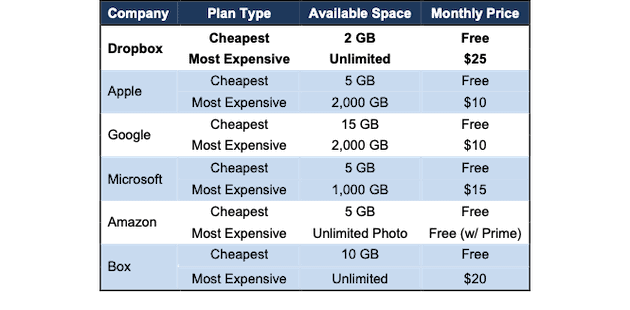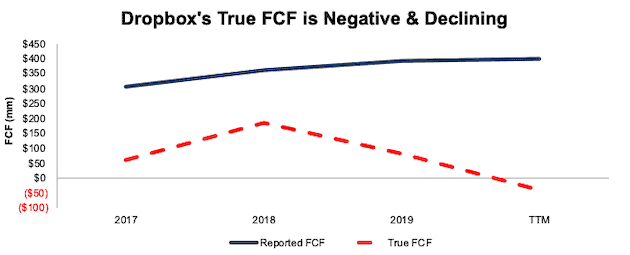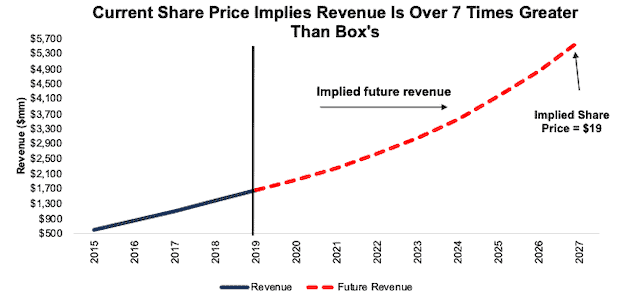We closed this Danger Zone pick on September 24, 2024. A copy of the associated Position Close report is here.
Check out this week’s Danger Zone interview with Chuck Jaffe of Money Life.
Despite years of rapid revenue growth and reaching profitability, the future for this cloud-based storage provider is murky at best. Entrenched competition is well-positioned to take more market share, but the stock is priced for just the opposite. Fiduciaries should avoid this week’s Danger Zone pick: Dropbox Inc. (DBX: $19/share).
We first warned about Dropbox prior to its IPO in March 2018, and again in September 2018 and August 2019. Since we first placed it in the Danger Zone, DBX is down ~8% while the S&P 500 is up 24%. While this stock has outperformed as a short, it could fall much further. Investors with fiduciary responsibilities should consider the deteriorating fundamentals, weak competitive position, and the unrealistic user growth implied by the current valuation.
This report helps investors of all types see just how extreme the risk in DBX is based on:
- Competition deeply already integrated with target users
- Slowing YoY revenue growth
- Misleading free cash flow
- Doing the math: the stock price implies Dropbox can acquire 44 million paying users, equal to 30% of Amazon Prime members and 22% of Microsoft Office 365 subscribers
More Revenue Decline Expected
While Dropbox has grown revenue from $845 million in 2016 to $1.8 billion TTM, the firm’s year-over-year (YoY) revenue growth rate has fallen from 40% to 18%. Consensus estimates show that the market expects the firm’s revenue growth rate to decline from 14% in 2020 to just 10% in 2022. The market also expects Dropbox to lose more market share given that the global cloud storage market is expected to grow much faster (by 22% compounded annually from 2020 to 2025).
Figure 1: Dropbox’s YoY Revenue Growth Since 2016

Sources: New Constructs, LLC, and company filings
*Consensus estimates
Growth of Paying Users Is Slowing Too
Despite focusing on workflow optimization and adding product features such as HelloSign, Passwords, and Spaces, Dropbox has been unable to reverse its declining growth rates.
Dropbox’s paying users, the primary source of revenue, are growing much more slowly too. Per Figure 2, the YoY growth in paying users has fallen from 35% in 2016 to just 10% TTM.
Figure 2: Dropbox’s YoY Change in Paying Users Since 2016

Sources: New Constructs, LLC and company filings
Dropbox Has to Steal Users From Deeply Integrated Solution Providers
Growing registered and paying users is a serious uphill battle for Dropbox since most of its potential paying users are already customers of firms that provide the same service as Dropbox along with many other important services. Figure 3 shows some of Dropbox’s direct competitors and their number of users, who have access to a free version of what Dropbox offers. For example, Google’s G Suite (which includes Google Drive) has 2 billion active users and Apple has 1.5 billion active devices (which include iCloud).
Figure 3: Dropbox & Competitors’ Users

Sources: New Constructs, LLC and company filings
Dropbox is at a disadvantage when it comes to competing for its competitors’ users.
For instance, Apple offers all of its customers 5 GB of free space through iCloud. Furthermore, each of these users may find Apple’s new Apple One subscription (which bundles iCloud, Music, TV, Arcade, Fitness, and News) more appealing than a third-party service. Dropbox not only has to convince customers not to use Apple’s convenient and competitively-priced service, but it also must convince them that Dropbox’s service is meaningfully better.
This WFH Solution Provider Saw Market Share Decline During COVID
Dropbox’s share of the global cloud storage market has fallen from 4.4% in 2017 to 3.6% in 2019 as more competitors enter the space and existing competition ramped up storage options.
With COVID-19-induced disruptions forcing most businesses to adapt their operations to be more remote friendly, Dropbox was in prime position to gain market share.
On the contrary, it is losing ground to the competition. Dropbox saw only a 16% YoY revenue increase in 2Q20 and a 17% YoY increase in 1H20. By comparison, Google Cloud’s revenue increased 43% YoY in 2Q20, and Microsoft grew its commercial cloud revenue by 39% YoY over the same period. If Dropbox cannot outgrow the competition in such a favorable environment, will it ever?
Additionally, Dropbox has not been nearly as efficient at converting free users to paid users. Dropbox has over 600 million registered users, but as of 2Q20, just 15 million (or 3% of registered users) were paying users. Meanwhile, Box (BOX), a direct competitor, had ~13 million paying users out of just 71 million registered users, or 18%, as of 2Q20. 20% of iCloud customers were paying users in 2018, the last time Apple shared that stat.
Inferior Offering at Higher Cost Limits Growth
Much of Dropbox’s competition offers cloud storage as an add-on to other core products and services that generate substantial profits. Consequently, these firms can offer cloud storage for free and still make plenty of money while Dropbox must make money on cloud storage.
Figure 4 shows that Dropbox offers neither the most storage nor the cheapest storage (excluding free tiers). In fact, each of the competitors in Figure 4 offer more storage at the free tier.
Having to charge users for services they can get free from competitors with whom they’ve already integrated puts Dropbox in a very poor competitive position.
Figure 4: Dropbox & Competitors’ Cloud-Based Storage Plans

Sources: New Constructs, LLC and company filings
Most of Dropbox’s Peers Are More Profitable Too
Most of Dropbox’s competition is more profitable too. Dropbox’s net operating profit after-tax (NOPAT) margin of 2% is well below the market-cap-weighted peer group average margin of 21%. This peer group includes Apple, Microsoft, Alphabet, Amazon, and Box.
Dropbox’s invested capital turns, a measure of balance sheet efficiency, ranks third out of the six companies listed in Figure 5. Dropbox’s return on invested capital (ROIC) only tops Box, and at less than 4%, is well below the peer group’s market-cap-weighted average of 48%.
Figure 5: Dropbox’s Peers Are More Profitable

Sources: New Constructs, LLC, and company filings
Competitive Pressures Force Costs To Rise Faster Than Revenue
Even though Dropbox faces more competition, the firm has successfully increased its average revenue per paying user (ARPU) from $111 in 2016 to $123 in 2019, or 3.6% compounded annually. However, the cost per user, or average operating expense per paying user (AOEPU) has risen even faster from $85 in 2016 to $99, or 5.2% compounded annually in 2019. Figure 6 illustrates that AOEPU is rising as a percent of average revenue per user and remains a significant impediment to the profitably improvements implied by the stock price, as we’ll show later.
Figure 6: AOEPU as a Percent of ARPU Since 2016

Sources: New Constructs, LLC and company filings
FCF Is Not What It Seems
Dropbox stated in its 2Q20 earnings call that it is on a trajectory to achieve its long-term free cash flow target of $1 billion by 2024. Over the past three years, Dropbox states it generated $1.3 billion in free cash flow (FCF).
However, upon closer look, Dropbox’s free cash flow fails to reflect the true economics of the business. For instance, the firm adds back stock-based compensation, a non-cash, but very real expense that dilutes shareholder value, to its calculation of FCF. Over the past three years the firm has incurred $1.1 billion in stock-based compensation expense.
When we close the accounting loopholes, we find that over the past three years, Dropbox generated a cumulative $329 million in true FCF and that FCF is rapidly declining. Over the TTM, the firm’s true FCF is -$40 million compared to reported FCF of $400 million. Figure 7 shows that while the firm’s reported FCF is trending up, Dropbox’s true FCF is moving in the opposite direction.
Figure 7: Dropbox’s Reported FCF vs. True FCF

Sources: New Constructs, LLC and company filings
Dropbox’s Slow Climb to Profitability
While Dropbox profits are trending higher, we do not believe the firm will be able to meet the expectations for future profit growth implied by its share price, given the competitive obstacles outlined above. Per Figure 8, Dropbox has grown revenue by 25% compounded annually since 2016. While core earnings[1] fell from -$58 million in 2018 to -$67 million in 2019, they rose to $17 million over the TTM.
Figure 8: Dropbox’s Revenue and Core Earnings Since 2016

Sources: New Constructs, LLC, and company filings
Dropbox Is Priced to Reach 44 Million Paying Users or 30% of Amazon Prime Members
Despite facing larger and more entrenched competition, Dropbox is priced as if it will quickly improve profitability while also increasing its average paying users to equal 30% of Amazon’s Prime members.
To justify its current price of $19/share, Dropbox must:
- Grow revenue at 17% (vs. average consensus estimates from 2020 to 2022 of 12%) compounded annually over the next eight years
- Immediately achieve a 7% (vs. Amazon’s TTM margin of 5%) NOPAT margin
See the math behind this reverse DCF scenario. In this scenario, Dropbox grows revenue by 17% compounded annually for eight years and reaches $5.6 billion in revenue in 2027, or 7.5 times more than the $737 million of revenue Box generated over the TTM.
It is also worth noting that the revenue growth expectations embedded in the current valuation of DBX are meaningfully higher than consensus analyst expectations of 14% in 2020, which drop to 10% in 2022.
Figure 9: Current Valuation Implies Unrealistic Revenue Growth

Sources: New Constructs, LLC and company filings.
Dropbox’s Average Paying Users Need to More Than Triple to Justify Valuation
To further illustrate the extraordinarily high growth expectations embedded in Dropbox’s stock price, we compare Dropbox’s implied paying users to the paying users of competitors. By dividing the implied revenue in 2027 of $5.6 billion by the firm’s 2Q20 ARPU of $126, we arrive at ~44 million implied paying users in 2027.
In other words, DBX’s current valuation implies the company will grow its paying user base to equal 30% of Amazon Prime members and 22% of Microsoft Office 365 subscribers today. 44 million paying users also translates to 2.5% of the global cloud storage market share.
We think it is difficult to make a straight-faced argument that Dropbox can maintain that level of market share with a more expensive and less integrated product.
Figure 10: Dropbox’s Implied 2027 Average Paying Users vs. Competitors

Sources: New Constructs, LLC and company filings.
Dropbox Has Significant Downside With More Realistic User Growth
If we assume more realistic revenue and profit growth, DBX has significant downside.
In this scenario, we assume Dropbox will:
- Grow revenue at 11% (equal to 2021 consensus estimate) compounded annually over the next eight years
- Immediately achieve a 4% NOPAT margin (double TTM margin of 2%)
See the math behind this reverse DCF scenario. In this scenario, Dropbox grows NOPAT from -$43 million in 2019 to $163 million in 2027, and the stock is worth just $7/share – a 63% downside.
Figure 11 compares the firm’s implied future NOPAT in this scenario to its historical NOPAT.
Figure 11: DBX Has Large Downside Risk: DCF Valuation Scenario

Sources: New Constructs, LLC and company filings.
Each of the above scenarios also assumes Dropbox is able to grow revenue, NOPAT and FCF without increasing working capital or fixed assets. This assumption is highly unlikely but allows us to create best-case scenarios that demonstrate how high expectations embedded in the current valuation are.
Acquisition Would Be Unwise
Often the largest risk to any bear thesis is what we call “stupid money risk”, which means an acquirer comes in and buys Dropbox at the current, or higher, share price despite the stock being overvalued. Given our analysis above, the only plausible justification for DBX trading at such a high price is the expectation that another firm will buy it. We think potential acquirers would be better off leaving cloud storage to the firms that can offer cloud storage as a free add-on to their deeply integrated services, but stranger things have happened than firms being acquired at unnecessarily high premiums to their intrinsic value.
Below, we quantify the high acquisition hopes that are priced into the stock.
Walking Through the Acquisition Math
First, investors need to know that Dropbox has large liabilities that make it more expensive than the accounting numbers would initially suggest.
- $864 million in operating leases (11% of market cap)
- $18 million in outstanding employee stock options (<1% of market cap)
After adjusting for all liabilities, we can model multiple purchase price scenarios. For this analysis, we chose Salesforce.com Inc. (CRM) as a potential acquirer of Dropbox since Dropbox already integrates with Salesforce’s cloud-based platform and such vertical integration would give Salesforce greater in-house services and access to Dropbox’s over 600 million registered users. While we chose Salesforce, analysts can use just about any company to do the same analysis. The key variables are the weighted average cost of capital (WACC) and ROIC for assessing different hurdle rates for a deal to create value.
Even in the most optimistic of scenarios, Dropbox is worth less than its current share price.
Figures 12 and 13 show what we think Salesforce should pay for Dropbox to ensure it does not destroy shareholder value. There are limits on how much Salesforce should pay for Dropbox to earn a proper return, given the NOPAT or free cash flows being acquired.
Each implied price is based on a ‘goal ROIC’ assuming different levels of revenue growth. In the first scenario, we use 14% revenue growth in year one and 11% in years two through five (vs. consensus estimates of 14% in 2020 and 11% in 2021). In the second scenario, the estimated revenue growth rate for year one is 14% in years one through five. We use the higher estimates in scenario two to illustrate a best-case scenario where we assume Dropbox could grow revenue faster while being integrated within Salesforce’s existing business.
We optimistically assume that Salesforce can grow Dropbox’s revenue and NOPAT without spending any working capital or fixed assets beyond the original purchase price. We also optimistically assume Dropbox achieves a 4% NOPAT margin, which is above Dropbox’s TTM margin of 2% and Salesforce’s TTM margin of 1%.
Figure 12: Implied Acquisition Prices for Value-Neutral Deal

Sources: New Constructs, LLC and company filings
Figure 12 shows the implied values for DBX assuming Salesforce wants to achieve an ROIC on the acquisition that equals its WACC of 6%. This scenario represents the minimum level of performance required not to destroy value. Even if Dropbox can grow revenue by 14% compounded annually for five years and achieve a 4% NOPAT margin, the firm is worth less than $19/share. It’s worth noting that any deal that only achieves a 6% ROIC would not be accretive, as the return on the deal would equal Salesforce’s WACC.
Figure 13: Implied Acquisition Prices to Create Value

Sources: New Constructs, LLC and company filings
Figure 13 shows the implied values for DBX assuming Salesforce wants to achieve an ROIC on the acquisition that equals 8% and is greater than its WACC. Acquisitions completed at these prices would be accretive to Salesforce’s shareholders. Even in this best-case growth scenario, the implied value is far below Dropbox’s current price. Without significant increases in the margin or revenue growth assumed in this scenario, an acquisition of DBX at its current price destroys significant shareholder value.
Catalyst – Slowing Revenue Growth With Increased Expectations
At the end of January, the consensus estimate for Dropbox’s 2020 earnings was $0.57/share. Jump forward to today, and the 2020 consensus estimate has risen to $0.77/share, despite underwhelming user growth during the shift to work-from-home. Dropbox has beaten earnings in each of the past ten quarters. The combination of the firm’s slowing growth rate and higher expectations make a future beat more difficult. Should the firm have its first earnings miss, investors could get spooked and send shares lower.
Further, Dropbox’s relative underperformance to its stronger peers during the COVID-19 disruptions could cause investors to wake up to the fact that Dropbox is losing market share and cause them to rotate their money into better investments.
The stock will also likely sink should any of its competitors get more aggressive and offer more cloud storage at even lower prices so that Dropbox’s value proposition gets only weaker.
What Noise Traders Miss With DBX
These days, fewer investors pay attention to fundamentals and the red flags buried in financial filings. Instead, due to the proliferation of noise traders, the focus tends toward technical trading trends while high-quality fundamental research is overlooked. Here’s a quick summary for noise traders when analyzing DBX:
- Deeply embedded competition with deeper pockets
- Slowing revenue growth rates
- Lack of significant and durable competitive advantages
- Valuation implies massive paying user growth
Executive Compensation Plan Is Not Creating Shareholder Value
In addition to base salaries, Dropbox’s executives earn cash bonuses and long-term equity incentive compensation. Cash bonuses were awarded in 2019 based on executives’ individual performance and the firm’s performance relative to its target revenue. In other words, executives are incentivized to focus on revenue, with little to no regard to the profitability of the firm. From Dropbox’s proxy statement, the compensation committee notes “annual revenue continued to be the best indicator of our successful execution of our annual operating plan.”
Dropbox ties its long-term performance awards directly to the performance of the firm’s stock by issuing time-based restricted stock units that vest over multi-year periods.
With ties to revenue and stock price, it’s not surprising that the firm’s executive compensation plan has not created shareholder value. Dropbox has generated negative economic earnings in each of the past four years.
Dropbox should link executive compensation with improving ROIC, which is directly correlated with creating shareholder value, so shareholders’ interests are properly aligned with executives’.
Insider Trading and Short Interest
Over the past three months, insiders have purchased 4 thousand shares and sold 99 thousand shares for a net effect of 95 thousands shares sold.
There are currently 20.7 million shares sold short, which equates to 5% of shares outstanding and just over three days to cover. The number of shares sold short has increased by 4% since last month.
Critical Details Found in Financial Filings by Our Robo-Analyst Technology
As investors focus more on fundamental research, research automation technology is needed to analyze all the critical financial details in financial filings as shown in the Harvard Business School and MIT Sloan paper, "Core Earnings: New Data and Evidence”.
Below are specifics on the adjustments we make based on Robo-Analyst findings in Dropbox’s 10-Qs and 10-K:
Income Statement: we made $67 million of adjustments, with a net effect of removing $9 million in non-operating expenses (1% of revenue). You can see all the adjustments made to Dropbox’s income statement here.
Balance Sheet: we made $1.4 billion of adjustments to calculate invested capital with a net decrease of $853 million. One of the most notable adjustments was $20 million in operating leases. This adjustment represented 1% of reported net assets. You can see all the adjustments made to Dropbox’s balance sheet here.
Valuation: we made $2.1 billion of adjustments with a net effect of decreasing shareholder value by $90 million. The most notable adjustment to shareholder value was $1 billion in excess cash. This adjustment represents 13% of Dropbox’s market cap. See all adjustments to Dropbox’s valuation here.
Unattractive Funds That Hold DBX
The following funds receive our Unattractive-or-worse rating and allocate significantly to DBX:
- Global X Cloud Computing ETF (CLOU) – 2.8% allocation and Unattractive rating
- PartnerSelect Smaller Companies Fund (MSSFX) – 2.7% allocation and Unattractive rating
- Catalyst Buyback Strategy Fund (BUYCX) – 2.6% allocation and Very Unattractive rating
- Columbia Seligman Comm & Info Fund (SLMCX) – 2.0% allocation and Unattractive rating
- Columbia Seligman Global Technology Fund (SHGTX) – 2.0% allocation and Unattractive rating
This article originally published on September 29, 2020.
Disclosure: David Trainer, Kyle Guske II, and Matt Shuler receive no compensation to write about any specific stock, sector, style, or theme.
Follow us on Twitter, Facebook, LinkedIn, and StockTwits for real-time alerts on all our research.
[1] Our core earnings are a superior measure of profits, as demonstrated in Core Earnings: New Data & Evidence a paper by professors at Harvard Business School (HBS) & MIT Sloan. The paper empirically shows that our data is superior to “Operating Income After Depreciation” and “Income Before Special Items” from Compustat, owned by S&P Global (SPGI).
